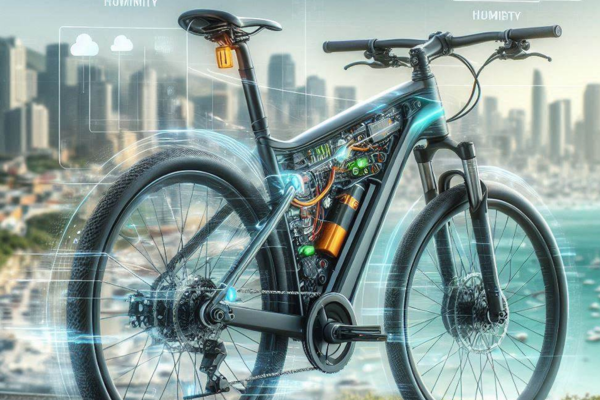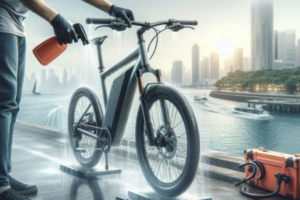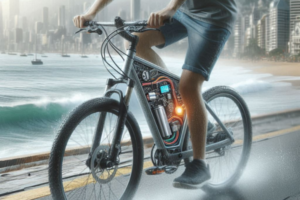Technologies to Improve the Energy Efficiency of Electric Bicycles in Humid Regions
🌧️ The Challenge of Riding Efficiently in Humid Environments
Electric bicycles are an essential tool in the shift toward sustainable mobility. They allow riders to move through cities, coastlines, and rural roads with low emissions and greater flexibility. But in regions where humidity dominates the climate — such as tropical, subtropical, and coastal areas — energy efficiency becomes more difficult to maintain.
Humidity introduces a silent but persistent set of challenges. Moisture builds up in electrical connectors, corrodes metal surfaces, increases rolling resistance, and compromises battery performance. These effects are subtle but cumulative, causing e-bike range to decline and ride quality to suffer — unless the rider knows how to combat them.
Fortunately, modern technology offers innovative ways to preserve and even enhance the energy efficiency of electric bicycles in humid conditions. From smart sensors to protective coatings, this article explores the tools that empower riders to go farther, smoother, and with more control — even when the air is heavy with moisture.
⚙️ Why Humidity Affects E-Bike Performance
To understand the value of technology in these environments, we need to break down how humidity directly impacts your bike’s energy system:
- 🔌 Corrosion of electrical connectors: High humidity encourages oxidation and contact degradation, which leads to increased resistance and energy loss at the point of transmission.
- ⚡ Battery performance instability: Internal condensation can lead to voltage drops, inefficient charging, and higher-than-normal energy consumption during rides.
- 🛠️ Increased drivetrain friction: Moisture mixes with dirt to create sludge that clings to chains and gears, increasing drag and reducing motor support efficiency.
- 🛑 Brake drag from moisture exposure: Even light surface rust or dirt on rotors increases resistance, requiring more power to maintain consistent speed.
- 💨 Reduced tire PSI due to pressure shifts: Warm, humid air causes tire pressure to fluctuate, which raises rolling resistance and lowers energy efficiency.
While no technology can eliminate humidity itself, several innovations now exist to address its effects — and help you preserve the energy that your battery stores.
💡 Perspective That Powers Performance
“You can’t stop the weather — but with the right tools, you can stop it from draining your power.”
The rest of this article will highlight technologies and products that defend your ride against the energy loss caused by humid air. Whether you’re commuting in Miami, riding along the Mekong, or navigating Jakarta’s streets after rainfall, these smart solutions will help you ride stronger, safer, and longer.
🔋 Smart Technologies That Improve Efficiency in Humid Conditions
Thanks to technological innovation, riders in humid regions no longer have to accept efficiency loss as inevitable. Several tools and systems are now available that specifically address the challenges caused by moisture, condensation, and corrosion. These technologies can be integrated into your e-bike, your maintenance routine, or your storage setup — each playing a vital role in protecting energy efficiency.
🔌 1. Sealed Battery and Connector Systems
Many modern e-bike manufacturers now offer sealed battery compartments and waterproof connectors with rubber gaskets. These systems create a moisture-resistant barrier that helps prevent corrosion and short circuits. If you’re upgrading or purchasing a new e-bike, look for models with IP65 or higher weatherproof ratings — especially for connectors and display panels.
📱 2. Integrated Energy Monitoring Apps
Advanced e-bikes often include smart battery monitoring systems connected to mobile apps. These allow you to track power usage, detect unusual energy drains, and monitor battery temperature. In humid regions, being able to quickly detect abnormal consumption or heat buildup can prevent damage caused by internal condensation.
🌡️ 3. Thermal Regulation and Ventilation Features
Some e-bike frames now incorporate passive ventilation designs to dissipate internal heat and moisture. This is especially useful in warm, humid environments where trapped humidity increases internal temperatures. Adding breathable, ventilated battery covers can also reduce the risk of overheating and help regulate energy efficiency.
🛢️ 4. Corrosion-Resistant Chain and Drivetrain Coatings
Technologies such as Teflon®, ceramic, or titanium-based coatings are being used in chains, cogs, and sprockets to reduce oxidation. These materials offer a smoother drivetrain interface and reduce the need for constant lubrication. E-bikes using coated components tend to roll more efficiently, even when exposed to persistent humidity or salt spray.
💨 5. Automatic Tire Pressure Monitoring (TPMS)
Some high-end e-bikes or accessories now include tire pressure sensors that notify riders of PSI drops via app or display. In humid environments, PSI fluctuations happen more frequently and affect rolling resistance. Maintaining optimal pressure reduces drag and preserves energy — especially on long commutes or uphill climbs.
📊 Comparative Table: Technology Benefits in Humid Regions
| Technology | Main Benefit | Humidity Impact Addressed |
|---|---|---|
| Sealed connectors | Protects battery and electronics | Prevents moisture entry and corrosion |
| Energy apps | Tracks consumption in real time | Identifies irregular performance patterns |
| Chain coatings | Reduces wear and resistance | Fights rust and drag buildup |
| TPMS | Ensures proper tire inflation | Maintains rolling efficiency |
💬 Tech Insight
“In humid regions, energy efficiency isn’t just about charging your battery — it’s about protecting every system that touches power.”
These tools don’t just make your e-bike smarter — they make it stronger. By leveraging the right technologies, you’re not just riding longer, you’re riding with confidence against the elements.
🌍 Real Story: How a Simple Upgrade Restored Efficiency in a Tropical City
Sofia is a daily e-bike commuter in Manila, Philippines — a city known for its heavy humidity, especially during monsoon season. When she first bought her electric bicycle, she was thrilled with the freedom it gave her to avoid traffic and reduce costs. But after a few months, she noticed her range dropping by 30%. The bike didn’t feel as smooth, and the battery took longer to charge. She feared she had bought a faulty model.
After talking with a local cycling group, Sofia learned her problem wasn’t the battery — it was the environment. She hadn’t accounted for the effects of humidity on her drivetrain and charging system. Her chain had developed rust despite regular rides, her charging port was collecting condensation, and her tire pressure was consistently low.
Guided by the group’s advice, Sofia made a few small but powerful changes:
- ✅ She installed a rubber-sealed charging port cover.
- ✅ Switched to a ceramic-lubed chain with rust-resistant coating.
- ✅ Bought a mini digital tire gauge and started weekly checks.
- ✅ Added a breathable battery protector to reduce condensation.
The result? Within two weeks, her range improved by 20%, and her rides felt smoother and more predictable. Sofia didn’t have to buy a new battery — she just had to adapt her maintenance and technology to fit her climate.
🛠️ Small Tech Upgrades That Make a Big Difference
Not every rider can invest in a new e-bike, but there are simple upgrades and accessories that can significantly boost energy efficiency in humid environments. These small changes offer high value and long-term protection:
- 🧼 Silicone port covers: Lightweight and inexpensive, they protect against condensation buildup in charging ports and cable interfaces.
- 🛢️ Wet-condition chain lubricant with ceramic particles: These resist wash-off and reduce chain friction in moist environments.
- 🧯 Moisture-absorbing pouches: Place one near your battery storage area or inside saddlebags to reduce ambient humidity.
- 🧊 Ventilated battery sleeves: These wraps allow airflow and help minimize internal heat and condensation without exposing the battery to rain.
- 🔧 Smart torque sensors: Some motor controllers now include torque-based power delivery that adjusts based on effort, improving energy use in difficult terrain or slick conditions common in humid cities.
Each of these tools helps reduce the friction — literal and metaphorical — between you and the environment. They’re especially valuable for commuters, delivery riders, or anyone who depends on consistent battery performance throughout the week.
💡 Takeaway Thought
“When the climate changes, don’t fight it — ride with it. The right tech isn’t an upgrade; it’s a bridge to smoother, longer, smarter rides.”
Sofia’s story shows that a humid city doesn’t have to shorten your ride. With smart additions and a little awareness, you can adapt your electric bicycle to thrive — not just survive — in any environment.
🚫 Common Mistakes Riders Make in Humid Environments
Even experienced e-bike owners make small mistakes that quietly impact their ride quality — especially in humid climates. These oversights often go unnoticed because their effects build slowly over time. But left unchecked, they reduce battery range, increase component wear, and add unnecessary resistance to every ride.
Let’s look at the most frequent issues and how to correct them with simple habits and accessible technologies:
- ❌ Ignoring moisture buildup around connectors: Charging ports and motor cable inlets are vulnerable to invisible condensation. Left unchecked, this leads to corrosion and energy inefficiency.
- ❌ Relying on dry-lubricants in a wet climate: Many default chain lubes are designed for dry conditions. In humid weather, they break down quickly, leaving metal parts exposed to rust and friction.
- ❌ Underestimating the effect of low tire pressure: Even a slight drop in PSI can significantly reduce energy efficiency, especially in environments where warm, damp air fluctuates pressure frequently.
- ❌ Storing the bike under sealed covers: While covers protect from rain, in humid regions they trap moisture — turning your storage into a corrosion chamber. Breathable materials are essential.
- ❌ Delaying firmware or system updates: Smart energy systems rely on up-to-date calibration. Failing to install manufacturer updates can leave sensors inefficient, draining energy instead of optimizing it.
📋 Weekly Tech-Aware Checklist for Humid Regions
To ride efficiently in high-humidity environments, consistency matters more than intensity. Here’s a 15-minute checklist you can use each week to keep your systems running at peak efficiency:
- ✅ Wipe moisture from display screen, battery casing, and connector points after every ride.
- ✅ Apply wet-condition lubricant to your chain and derailleur every 5–7 days.
- ✅ Use a mini tire pressure gauge to maintain PSI at manufacturer levels.
- ✅ Inspect your brake rotors for film or rust and clean with alcohol when needed.
- ✅ Update your e-bike’s app and firmware monthly to ensure optimal energy calibration.
- ✅ Remove your battery for indoor storage during especially humid nights or rainy weeks.
By keeping this checklist visible — perhaps attached to your wall-mounted charger or inside your storage shed — you form habits that protect both your bike and your time. The result: longer rides, better range, and less stress.
💬 Empowerment Reminder
“Small habits don’t just protect your bike — they multiply your energy. Every wipe, check, and click is a step toward riding smarter.”
In the battle against humidity, consistency is your strongest ally. It’s not about perfection — it’s about prevention. When you combine the right tools with the right behaviors, your e-bike can deliver its full potential, regardless of climate.
❓ Frequently Asked Questions (FAQs)
Can technology really help preserve energy in humid weather?
Yes. Technologies such as waterproof connectors, smart battery apps, chain coatings, and tire pressure monitoring systems directly reduce the energy loss caused by friction, corrosion, and inefficiencies. The right tools minimize the invisible resistance introduced by moisture in the air.
Is it worth upgrading older e-bikes with new tech?
Absolutely. Even modest upgrades like a new chain lubricant, rubber port covers, or a pressure gauge can significantly improve performance in humid climates. You don’t need a brand-new bike — just the right enhancements based on your environment.
How often should I check my tire pressure in a humid region?
At least once a week. Humidity and heat affect tire pressure more than most riders realize. Keeping your PSI consistent helps you ride farther and more comfortably with less battery drain.
Can moisture really affect the battery without visible damage?
Yes. Humidity leads to internal condensation, especially when bikes are stored in poorly ventilated spaces. Even without visible water, this can cause power fluctuations, slower charging, or long-term battery degradation.
Are smart e-bikes better for riding in humid climates?
Smart e-bikes often include sensors and software that help detect early signs of inefficiency. While any bike can perform well with proper care, smart features can give you an edge in preventing energy loss in complex environments.
💬 Final Thoughts
Technology doesn’t exist to complicate our rides — it exists to enhance them. In humid regions, every drop of moisture carries the potential to reduce performance, but every smart decision you make is a countermeasure. With just a few tools and mindful habits, you can restore the energy your bike was built to deliver.
Think of your e-bike not just as a vehicle, but as a living system — one that thrives when nurtured and protected. The climate may not change, but your approach can. And with the right technologies in place, you’re not just adapting — you’re riding further, smoother, and smarter.
🌟 Let’s Ride Together
Are you using tech to improve your e-bike’s energy in a humid city? Have you tried a smart monitor, a new type of chain, or a trick to keep moisture away from your battery?
We’d love to hear from you in the comments. Every rider’s experience helps others feel more confident and capable — and your story might inspire someone to make the upgrade that changes everything.
Let’s build a community of mindful riders — connected by tech, empowered by care, and driven by purpose.



